Key takeaways:
- Understanding donor feedback enhances relationships by uncovering motivations and personal connections, fostering a sense of value among supporters.
- Incorporating donor insights into strategies, such as communication and project selection, leads to improved engagement and participation.
- Transparency in sharing results, including successes and failures, reinforces trust and strengthens partnerships with donors.
- Regular, personalized communication and feedback loops transform donors into active participants in the mission, enhancing overall community involvement.

Understanding donor feedback
Understanding donor feedback is a vital aspect of fostering meaningful connections between charities and their supporters. I remember a time when I received a heartfelt thank-you note from a donor who shared how our program impacted their life directly. It struck me that this simple feedback not only validated our efforts but also illuminated the real-life implications of charitable contributions.
When I analyze donor feedback, I often wonder: What drives their generosity? Exploring this question has led me to realize that understanding a donor’s motivations can significantly enhance our approach. For instance, I once found that a donor was inspired by a personal experience related to our mission. This insight helped us tailor our communication to resonate more deeply with this individual, making them feel connected and valued.
It’s not just about crunching numbers or assessing donations; it’s about listening to the stories behind the gifts. Each piece of feedback offers a glimpse into the donor’s perspective, pushing me to empathize and adjust our strategies accordingly. I recall a specific instance where constructive criticism led us to revamp our outreach materials, resulting in increased donor engagement. This shows that donor feedback is not merely a formality; it’s a powerful tool for growth.
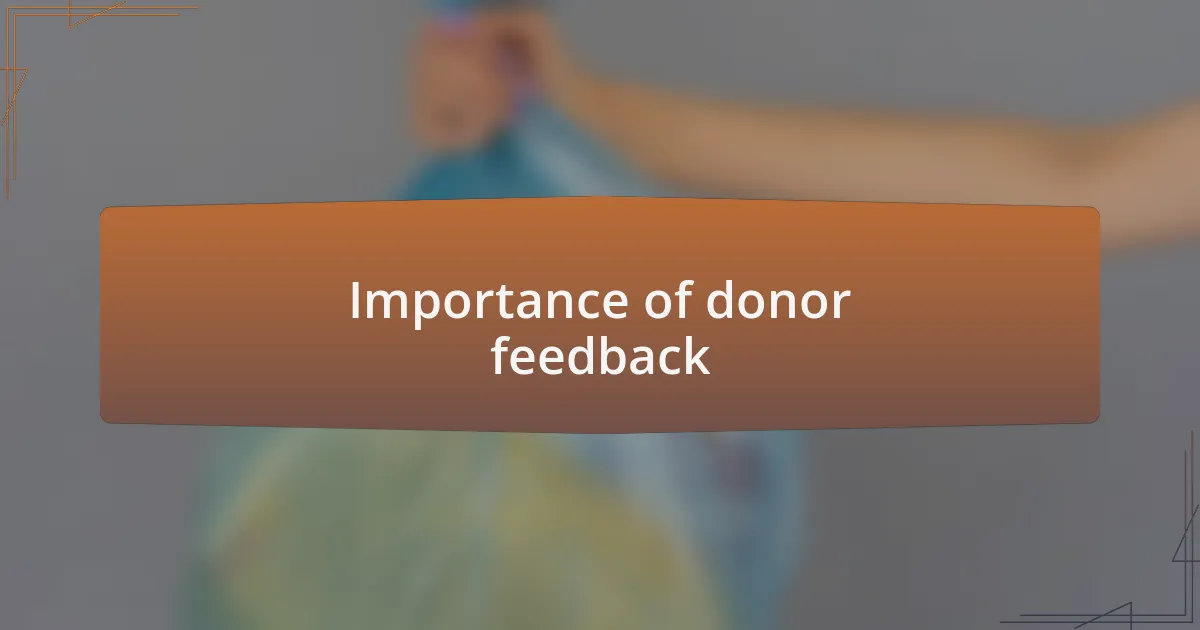
Importance of donor feedback
Donor feedback plays a crucial role in shaping the effectiveness of charitable organizations. I remember a moment when we received suggestions from a few donors regarding our annual report. Their insights not only helped us present our achievements more transparently but also fostered a sense of inclusion among supporters. Isn’t it fascinating how open communication can transform a simple report into a shared narrative of impact?
Listening to donor feedback allows us to build trust and forge stronger relationships with our supporters. For example, during a campaign, I engaged in a conversation with a long-term donor who expressed concerns about our messaging. This candid exchange led us to refine our strategy, ensuring that we communicated our mission with clarity and passion. It made me realize just how essential it is to value donor input; it’s not just what they give, but how they feel about our work that matters.
Incorporating feedback demonstrates to donors that their opinions are valued, which ultimately influences their continued support. I can recall a time when a donor’s suggestion directly inspired a new initiative. The joy in their voice as they saw their idea come to life was unforgettable. Such moments affirm that when donors feel heard, they become not just contributors, but active participants in our mission. Isn’t that the ultimate goal of charitable giving?
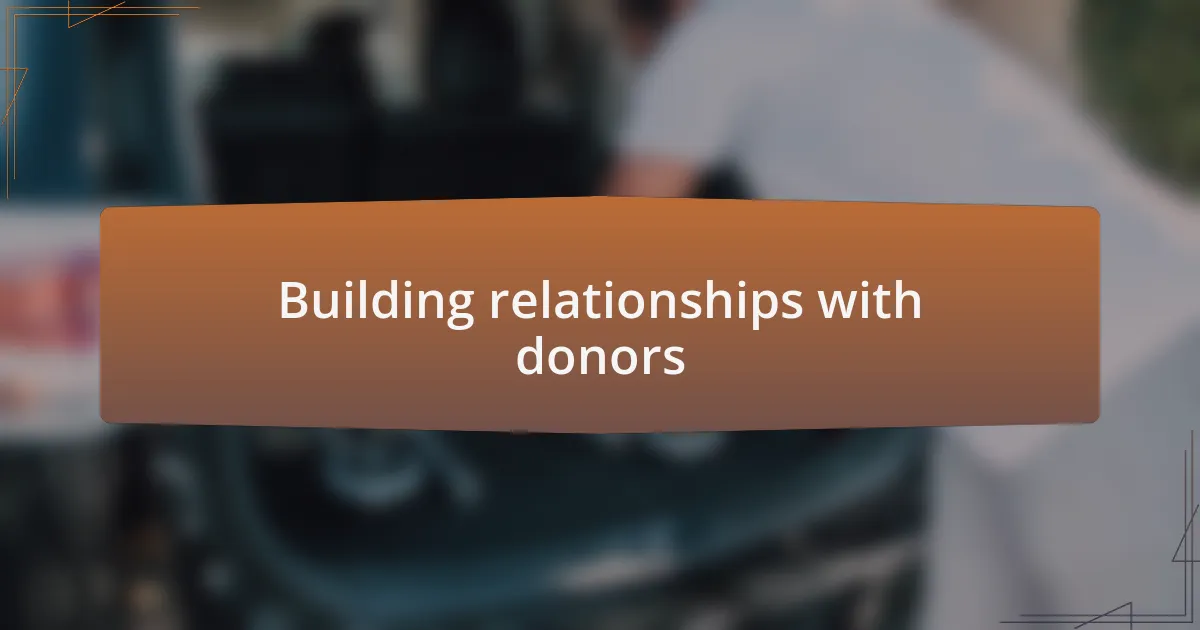
Building relationships with donors
Building relationships with donors goes beyond mere transactions; it is about creating a community. I still recall a donor who shared a heartfelt story about how our organization impacted their family’s life. That conversation stayed with me, highlighting how personal connections can deepen our understanding of our mission and inspire both parties. Have you ever noticed how a simple story can bridge gaps and foster genuine connections?
Engagement with donors also presents opportunities for collaborative growth. I once invited a small group of donors to participate in a brainstorming session about future projects. Their excitement was palpable as we exchanged ideas, resulting in innovative solutions that benefited everyone involved. Isn’t it rewarding when collaboration transforms our donors from passive supporters into passionate advocates for our cause?
Moreover, maintaining regular communication is vital for nurturing these relationships. I’ve found that sending personalized updates, whether via email or handwritten notes, reinforces our commitment to transparency and appreciation. When donors see the impact of their contributions reflected in real-time stories, it cultivates loyalty and a sense of belonging. Do you feel that kind of engagement can make a difference in how donors perceive their impact?
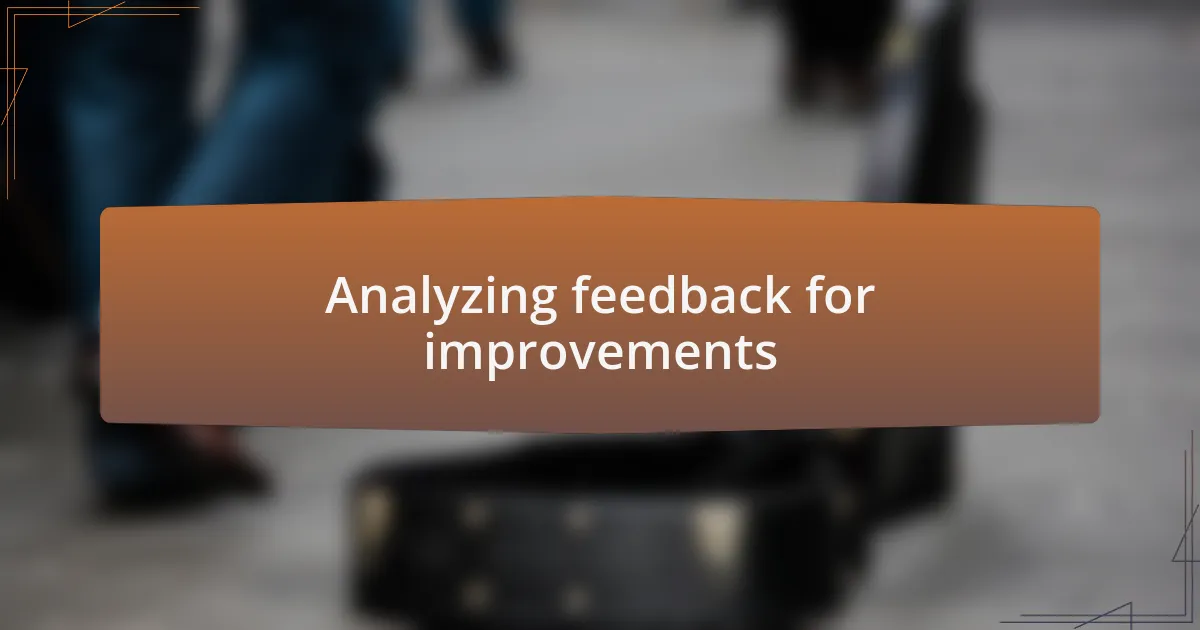
Analyzing feedback for improvements
Analyzing feedback is a vital step in enhancing our initiatives and strengthening our donor relationships. I remember a specific instance when I received thoughtful critiques from a donor about our outreach strategy. Their insights led me to re-evaluate our messaging, allowing us to connect more authentically with our audience. Have you ever had a moment where feedback turned your perspective around completely?
Utilizing donor feedback requires not just acknowledgment but a commitment to implement changes. After gathering input on our annual event, I took the time to address each suggestion in our planning meetings. It was gratifying to see how small adjustments based on their feedback, like improving event accessibility, significantly increased participation the following year. Can you imagine the sense of ownership our donors felt knowing their voices shaped our plans?
Moreover, tracking feedback trends over time can illuminate broader themes that might otherwise go unnoticed. I once compiled a report analyzing donor sentiments from multiple surveys, revealing a consistent desire for greater transparency. This prompted me to adopt a more upfront approach in our communications. How often do we overlook the patterns hidden in feedback that could lead to meaningful change?
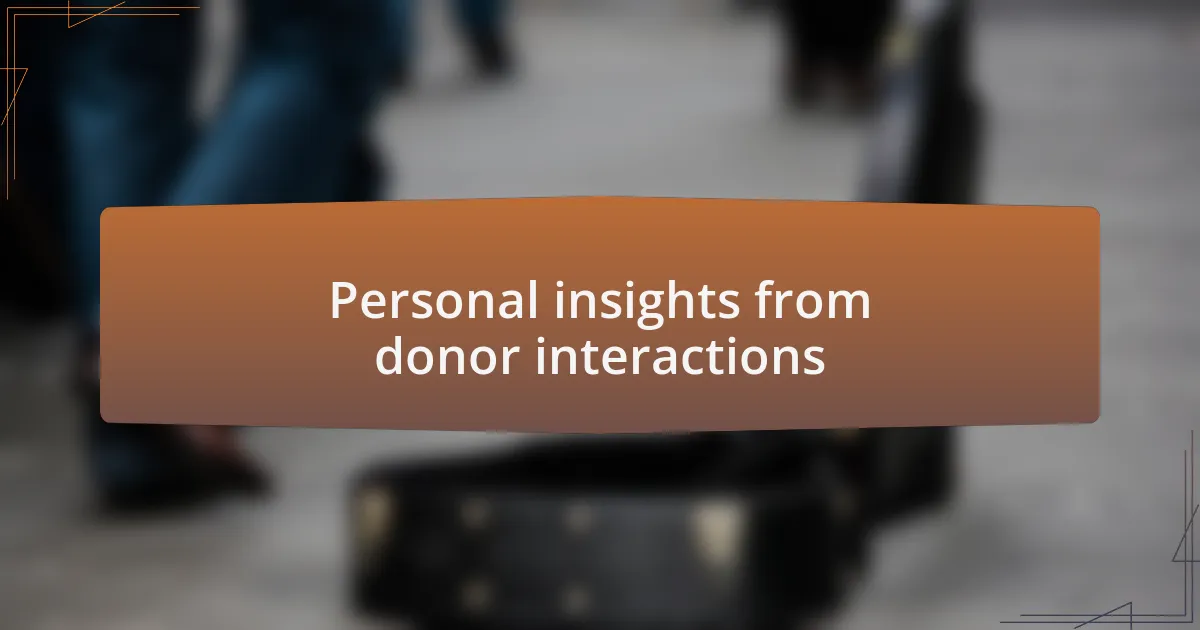
Personal insights from donor interactions
Building relationships with donors often provides surprising insights. I recall a moment when a donor shared their personal story about how our work impacted their community. It struck me deeply, reminding me that our mission is not just a job; it’s about fostering real connections. Have you ever thought about the personal stories behind every donor contribution?
In moving conversations one step further, I’ve found that open discussions lead to unexpected suggestions. A donor once mentioned wanting to see more detailed project updates. This made me realize the importance of transparency and the power of keeping donors informed. It’s incredible how simple exchanges can spark new ideas; have you ever noticed how a single question can change the entire dialogue?
Additionally, there’s a profound value in understanding donor motivations. After chatting with a recurring donor who had initially joined out of a passion for education, I learned how their values aligned with our mission. This inspired me to share these common values in our outreach efforts, which ultimately attracted even more supporters. How often do we take the time to uncover what truly drives our donors?
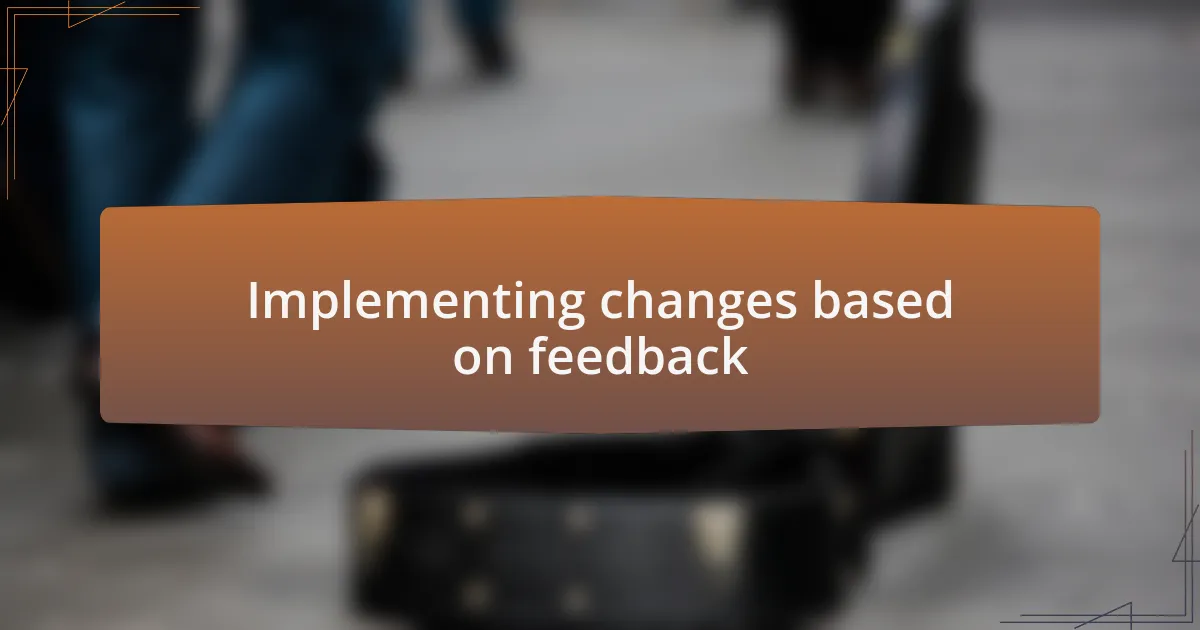
Implementing changes based on feedback
When it comes to implementing changes based on donor feedback, I have learned to listen closely. A while back, after receiving constructive criticism about our communication frequency, I decided to experiment with monthly newsletters. The result was astounding; not only did open rates increase, but donors also expressed appreciation for the updates. Isn’t it intriguing how making this simple adjustment can strengthen relationships?
I also recall a time when a donor suggested we incorporate more storytelling into our campaign materials. At first, I was skeptical — would it truly make a difference? But after integrating compelling stories from beneficiaries into our outreach, I felt the shift in engagement. Donors resonated more deeply with our mission, and we saw an uptick in contributions. Isn’t it fascinating how the right words can foster a genuine connection?
Another pivotal moment came from feedback about our project selection process. A donor expressed a desire to see initiatives that aligned more with community-driven needs. Taking this to heart, I initiated a series of discussions with local stakeholders. This collaboration not only shaped our upcoming projects but also created a sense of ownership among the community. What can be more rewarding than knowing that we are moving together toward a common goal?
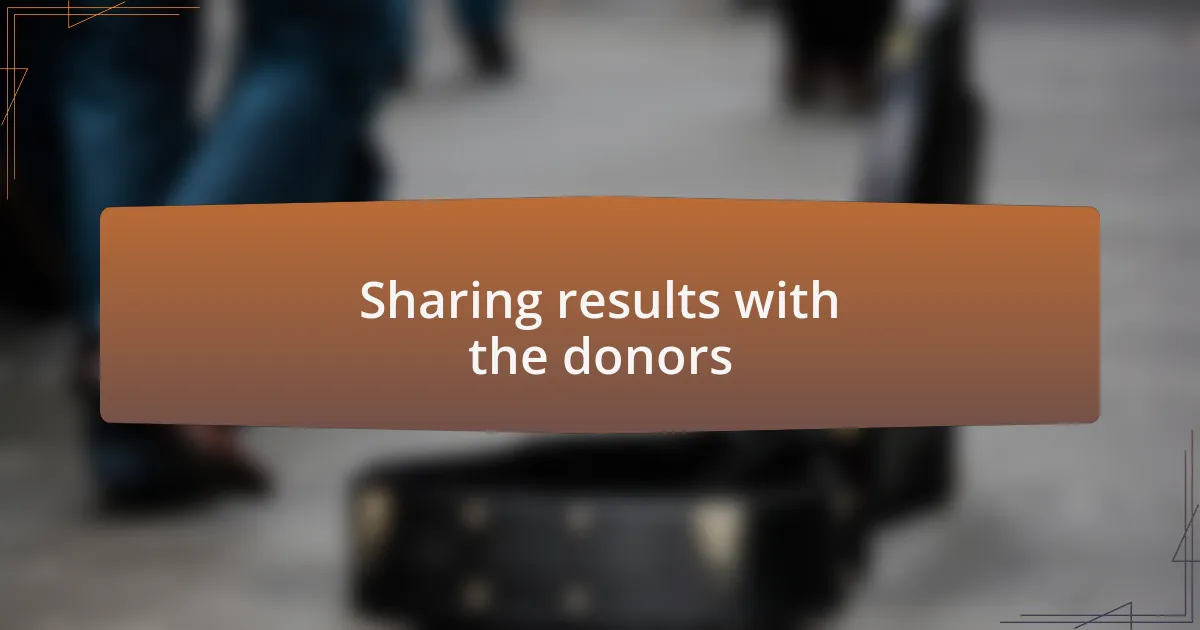
Sharing results with the donors
When sharing results with our donors, I’ve found that transparency is key. I remember the first time we publicly shared the tangible outcomes of a funded project. The excitement in the feedback was palpable; donors expressed feeling valued and connected to the mission. Isn’t it remarkable how sharing success stories can reinforce trust and loyalty?
There have been instances where I shared not just successes but also lessons learned. After completing a project, I sent out a detailed report highlighting both achievements and areas for improvement. A donor responded, sharing their own experiences with setbacks and praising our honesty. This kind of open dialogue fosters stronger partnerships; it’s empowering to recognize that we are all in this together, learning and evolving.
I also love using social media to share quick updates because it keeps the conversation lively. One specific update about funds allocated to a new program received numerous comments from donors, reflecting excitement and curiosity. They wanted to know more about how their contributions were making a difference. Engaging donors in this way not only informs them but also ignites a sense of community and shared purpose. How often do we get the chance to celebrate together?